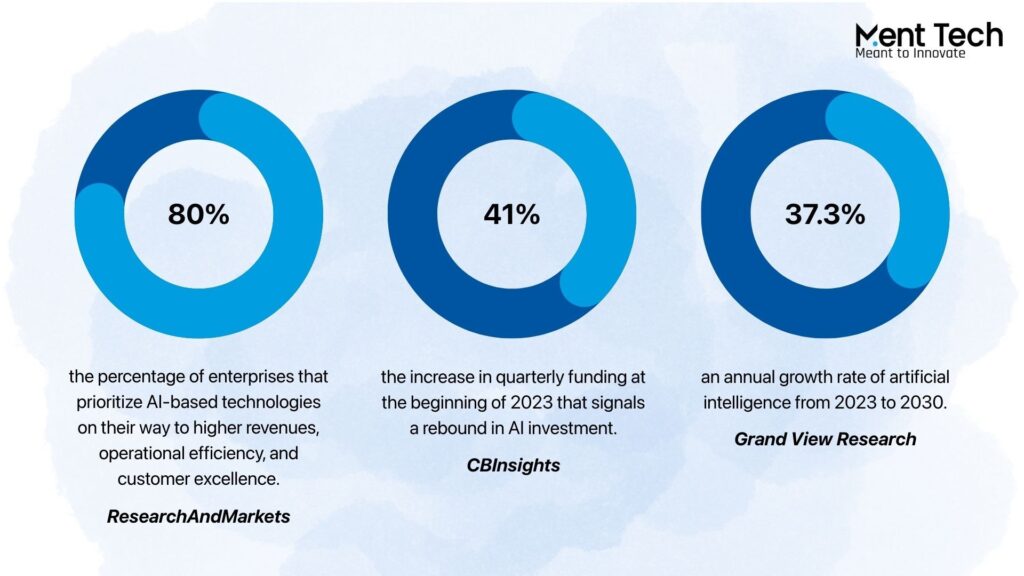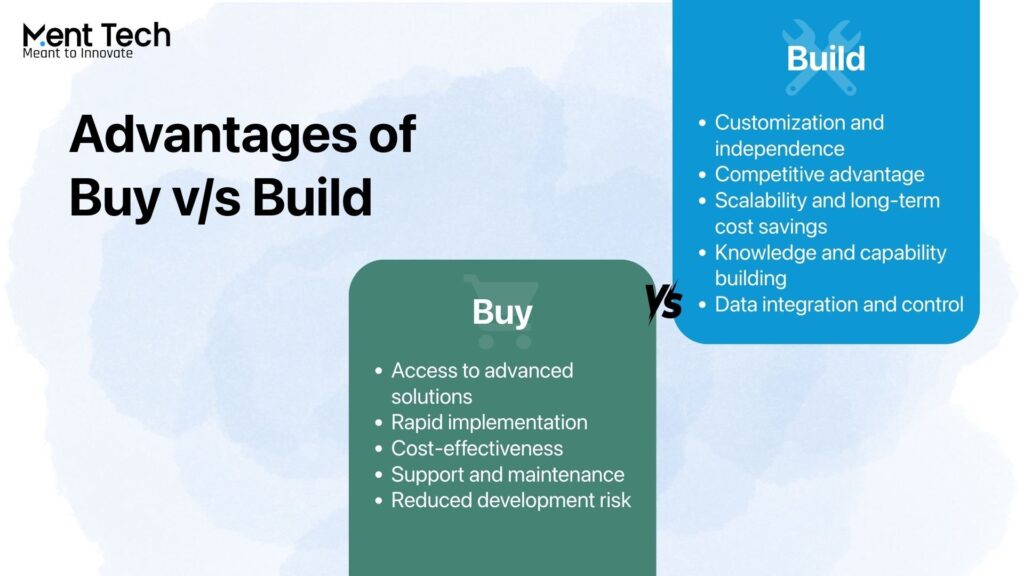Businesses today are under constant pressure to modernize IT systems that must be faster, smarter, and highly reliable. But with hybrid clouds, legacy systems, and complex distributed environments producing massive amounts of data, traditional reactive approaches are no longer enough to keep operations running smoothly.
This is where the build vs. buy decision becomes critical. Should enterprises develop custom AI solutions designed for their infrastructure or adopt proven commercial platforms for faster deployment? The choice directly impacts performance, costs, and long-term competitiveness. Relying on manual processes often leads to slower issue resolution, higher expenses, and operational inefficiencies.
The right AI strategy can redefine IT operations, enabling predictive monitoring, quicker root-cause detection, and intelligent automation that keeps systems resilient, proactive, and future-ready.
Recent industry data reveals a striking trend: According to Gartner’s 2025 IT Operations Management Survey, 78% of enterprise organizations are actively evaluating or implementing AI-driven solutions for IT operations, with spending on AI for IT operations expected to reach $47.2 billion by 2026 a 34% increase from 2024.

How the Build vs. Buy Decision Impacts IT Performance?
Buy or build AI: that’s the critical question organizations face today. In a rapidly evolving AI landscape, choosing the right approach can save months of development, cut costs, and drive better outcomes.
AI for IT operations is unlike traditional software. It requires deep expertise, ongoing model training, and seamless integration with complex enterprise systems. A wrong choice can mean wasted resources and missed opportunities.
Enterprise IT leaders face a tough call:
- Build In-House: Customizable, but internal teams may lack the specialized skills in machine learning, natural language processing, and distributed systems to deliver an effective solution.
- Buy Commercial Tools: Faster deployment and vendor support, but off-the-shelf products may not fully fit existing infrastructure or meet unique operational needs.
Modern enterprises run on a mix of cloud, on-premises, and legacy systems. To succeed, AI for IT operations must connect all these layers, turning data into actionable insights and automating processes effectively.
A real-world example—the recent case of a Fortune 500 financial services company that spent 18 months building a custom incident response automation system, only to discover that commercial alternatives had evolved significantly during their development cycle.
Meanwhile, a similar organization that chose an AI development approach for its monitoring solution achieved production deployment in six weeks.

Key Differences Between Building and Buying AI Systems
Deciding to build or buy an AI system depends on several critical factors. Organizations must weigh the development timeline, level of customization, ongoing maintenance needs, and overall cost of ownership before choosing the most suitable path.
The Build Approach
Building AI tools in-house gives organizations full control and flexibility. Many rely on AI development services to create tailored solutions that align with unique infrastructure, processes, and compliance requirements. However, this path demands significant time, investment, and a dedicated expert team.
- Maximum Control & Customization – Solutions are tailored to fit specific infrastructure, processes, and compliance needs.
- Specialized Teams Required – Data scientists, ML engineers, and DevOps specialists work together to build proprietary algorithms and interfaces.
- Unique Integrations – Enables support for proprietary protocols or industry-specific standards not available in off-the-shelf tools.
- High Investment – Demands significant time, budget, and ongoing maintenance to ensure reliability and performance.
The Buy Approach
Opting for commercial AI solutions offers speed, reliability, and vendor-backed support. Many organizations use vendor-backed AI deployment and integration services to leverage ready-made platforms with proven use cases, reducing the internal workload and ensuring faster ROI.
- Faster Time-to-Value – Pre-built platforms like Splunk ITSI, IBM Watson AIOps, and Moogsoft offer immediate deployment.
- Proven & Reliable – Commercial tools are tested across enterprises and updated regularly to match evolving IT challenges.
- Built-in Integrations – Comes with ready-to-use connectors, automation features, and best practices.
- Lower Internal Burden – Allows teams to focus on core business applications while vendors handle AI operations support and updates.
What Are the Key Factors in Build vs Buy AIOps Automation?
The build vs buy AIOps automation decision hinges on several critical factors that vary significantly across organizations.
Understanding these factors helps IT leaders make informed choices aligned with their strategic objectives and operational constraints.
| Factor | Build Approach | Buy Approach |
| Time to Deployment | 12-18 months for full solution | 4-8 weeks for initial deployment |
| Initial Investment | $500K – $2M+ (team, infrastructure, development) | $100K – $500K (licensing, implementation) |
| Customization Level | Complete control over features and functionality | Configuration within platform constraints |
| Ongoing Maintenance | Full internal responsibility for updates and support | Vendor-managed updates and support |
| Scalability | Depends on architecture decisions and team expertise | Proven scalability across enterprise environments |
| Integration Complexity | Custom integrations for all systems | Pre-built connectors for popular tools |
Technical Capabilities and Requirements
Evaluating AI for IT operations build or buy requires a thorough assessment of technical requirements. Organizations must consider their current infrastructure complexity, data volume and variety, integration requirements, and performance expectations.
Generative AI for IT operations adds another layer of complexity, requiring specialized expertise in large language models, prompt engineering, and natural language processing. Few organizations have the internal capability to develop and maintain these sophisticated systems effectively.
The choice between build or buy AI agent for ITOps often comes down to whether the organization has the technical depth to develop, deploy, and maintain agentic AI for IT operations solutions. This includes not just initial development, but ongoing model training, performance optimization, and adaptation to evolving infrastructure requirements.
How Do Real-World Applications Impact the Decision?
Real-world applications of AI in IT operations vary across industries, and these differences often shape the build vs. buy choice. Here’s how key sectors approach AI operations automation:
1. Financial Services
Banks and financial institutions blend commercial monitoring platforms with custom AI agents for compliance, fraud detection, and operational efficiency. This hybrid approach allows organizations to meet unique technical requirements while maintaining regulatory alignment.
2. Healthcare
Hospitals and healthcare providers adopt commercial AI tools with pre-built connectors for legacy systems, enabling smooth integration with EHRs and medical devices. These solutions help ensure compliance, patient safety, and uninterrupted care delivery.
3. Manufacturing
Manufacturers deploy hybrid AI, combining commercial tools for IT monitoring with custom-built solutions for proprietary industrial protocols. This approach supports predictive maintenance and seamless IT-OT integration on production floors.
4. Retail
Retailers use AI-driven platforms for real-time personalization across web and mobile channels, tailoring recommendations to evolving customer behaviors. This enhances shopping experiences while driving higher conversions and loyalty.
5. Logistics & Supply Chain
Logistics providers leverage AI for dynamic route optimization, factoring in traffic, weather, and delivery constraints. These capabilities help reduce costs, improve delivery speed, and ensure reliable supply chain operations.
6. Automobile
Automakers integrate commercial monitoring systems with specialized security applications to track production line performance and ensure data integrity. This enhances efficiency, predictive maintenance, and product quality in connected vehicle ecosystems.
7. Telecommunications
Telecom operators rely on AI platforms to manage massive, distributed networks with real-time anomaly detection and traffic optimization. These solutions ensure seamless connectivity, reduced downtime, and better customer experiences.
What Does It Cost to Build vs Buy AI Operations Solutions?

Understanding the true cost of AIOps build vs buy requires examining both direct and indirect expenses over the solution lifecycle.
Many organizations underestimate the total cost of ownership for custom development, particularly the ongoing maintenance and evolution requirements.
1. Build Approach Costs
Custom development of AI for IT operations solutions typically requires a team of 6-12 specialists, including data scientists, machine learning engineers, full-stack developers, and DevOps engineers. Annual team costs range from $800K to $2.4M depending on location and seniority levels.
Infrastructure costs for model training and deployment add $50K-$200K annually, depending on data volume and computational requirements. Organizations must also factor in costs for data preparation, model validation, and ongoing performance monitoring.
Development timelines typically span 12-18 months for initial deployment, with additional time required for optimization and integration. The opportunity cost of delayed value realization can be substantial, particularly in rapidly evolving IT environments.
2. Buy Approach Costs
Commercial AI tools for IT operations typically use subscription-based pricing models, with annual costs ranging from $100K to $500K for enterprise deployments. This includes licensing, support, and regular updates to keep pace with evolving technologies and threats.
Implementation services add $50K-$150K for initial deployment and integration, but organizations can typically achieve production deployment within 4-8 weeks. The faster time-to-value often justifies the ongoing subscription costs, particularly when compared to the extended development timeline of custom solutions.
Many organizations find that working with an AI development company for implementation and customization provides the best balance of speed and customization for commercial platform deployments.
The decision between build vs buy AIOps automation often comes down to whether organizations have the internal expertise to develop and maintain sophisticated AI tools for IT operations.
Optimize IT Performance with Our Expert AI Technologies
Our expert AI technologies help IT operations run smarter and faster. From machine learning to NLP, computer vision, and automation, we enable efficiency, predictive insights, and seamless decision-making.
1. Machine Learning
Machine learning models analyze large datasets to predict incidents, optimize resources, and uncover patterns. Custom models allow tailored predictions, while commercial solutions offer faster deployment and ready-to-use analytics.
2. Natural Language Processing (NLP)
NLP interprets logs, alerts, and tickets in natural language. Building in-house ensures alignment with internal workflows, while commercial platforms provide quick, plug-and-play AI integration.
3. Computer Vision Models
Computer vision detects anomalies and monitors infrastructure or video feeds. Custom models target specific operational needs, while pre-trained solutions accelerate deployment across standard environments.
4. Robotic Process Automation (RPA)
RPA automates repetitive IT tasks like patching, maintenance, and alert handling. Internal development allows bespoke workflows, while commercial tools enable immediate automation with vendor support.
5. Large Language Models (LLMs)
LLMs understand context, generate explanations, and provide intelligent guidance for IT operations. Building in-house allows workflow customization, while commercial LLMs offer rapid deployment and pre-trained capabilities.
6. Digital Virtual Assistants
AI-powered virtual assistants help IT teams handle queries and guide troubleshooting. Custom assistants align with internal processes, while commercial options deliver quick deployment with standard functionalities.

Conclusion
IT operations are evolving fast, and organizations face a critical choice between building in-house or buying commercial solutions. The right decision affects efficiency, costs, and business outcomes, while AI solutions must integrate seamlessly, provide actionable insights, and optimize performance across complex IT environments.
Ment Tech Labs, a leading AI consulting company, helps enterprises determine the most effective build vs. buy strategy. From a custom solution to a commercial platform for speed, or a hybrid approach, we provide the strategy, expertise, and technical support to ensure real impact.
Connect with Ment Tech Labs today to hire AI developers who implement AI-driven IT operations, boost efficiency, reduce costs, and deliver real business value.
Frequently Asked Questions
Consider your technical capabilities, timeline requirements, budget constraints, integration needs, and long-term strategic objectives. Organizations with strong internal AI expertise and unique requirements may benefit from building, while those seeking rapid deployment often prefer commercial solutions.
Custom development typically requires 12-18 months for full deployment, while commercial solutions can often be implemented within 4-8 weeks. However, commercial solutions may require additional time for customization and integration with existing systems.
Commercial platforms offer proven functionality, rapid deployment, pre-built integrations, vendor support, and continuous updates. They enable organizations to focus internal resources on core business applications while leveraging specialized vendor expertise.
Custom development makes sense when you have unique requirements that commercial solutions can’t address, strong internal AI expertise, regulatory constraints requiring custom solutions, or when AI operations capabilities represent a competitive advantage.
Custom development typically costs $500K-$2M+ initially with ongoing maintenance costs, while commercial solutions range from $100K-$500K annually. However, total cost of ownership over 3-5 years often favors commercial solutions due to reduced maintenance overhead.
Yes, many successful implementations use hybrid approaches, leveraging commercial platforms for core functionality while developing custom components for unique requirements. This strategy can accelerate time-to-value while maintaining flexibility.
Generative AI enables natural language interaction, automated documentation, intelligent troubleshooting guidance, and conversational interfaces for IT operations. It’s becoming increasingly important for making AI operations tools more accessible to non-technical users.


